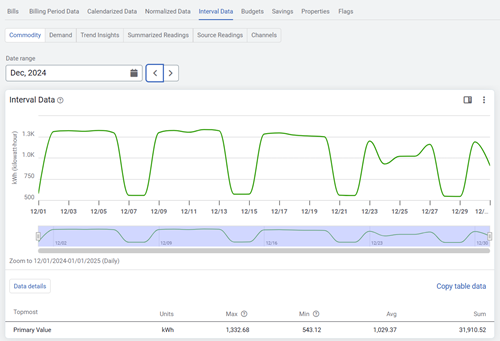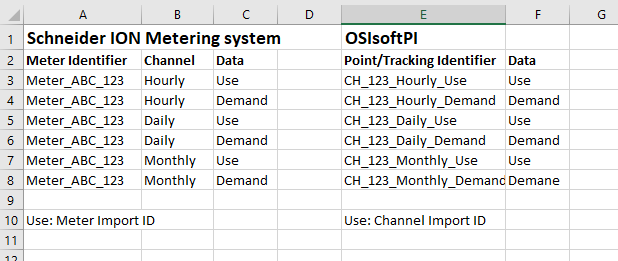Channels overview
A channel stores interval data for a specific type of utility measurement, like electricity use or demand. Each meter can have multiple channels to track different types of interval data.
Available channel intervals
- 5-minute
- 10-minute
- 15-minute
- 30-minute
- Hourly
- Daily
- Weekly
- Monthly
What do channels track
Channels typically store:
- Use (for example, kWh)
- Demand (for example, kW)
- Temperature
Adding channels
You can add channels at any time to collect more types of data. However, you must create channels in the application or by using spreadsheets before importing interval data.
Primary channels
Every meter that stores interval data needs:
- One primary value channel (required)
- One primary demand channel (optional)
These primary channels appear in Powerview charts.

Channel tags
When you view a meter's channels, tags help you identify:
- Primary value and primary demand channels
- The meter channels type, such as:
- Trip
- Odometer
- Calculated

Channel terms
Terminology used when creating a channel.
- Type ‒ Data type associated with the channel. (for example, use, demand).
- Interval ‒ The frequency at which readings are collected.
- If your interval is not listed, choose the closest match with lower granularity. For example, If you data interval is 20 minutes, select 30 minutes, not 15.
- For calculated channels, the interval is selected automatically based on the intervals of the source channels in the formula.
- Name ‒ Is populated for you but you can update it.
- Summarization method ‒ This determines how the data on the channel is aggregated over time. For most use interval data, the method will be Sum (15-minute electric use). For temperature select Average and for Demand select Max.
- Channel Import ID ‒ Unique ID used to identify the specific channel when importing readings. (Different from the meter import ID which is used for any channel on the meter.)
- Is Primary Value ‒ Select to set this channel as the Primary Value.
- Description ‒ Add more information about the channel.
- Channel is calculated ‒ When selected, the New Channel dialog is updated to include the channel formula and units. After a channel has reading this option cannot be changed. Calculated channels cannot be versioned.
Trip and odometer channels
- Trip channels
Reset after each reading or capture an instantaneous value (partial counter). - Odometer channels
Readings continually increase, like a car odometer (total counter).
Key terms
- Multiplier
Converts source readings to specified units. - Offset
Used with trip meters to track use from a known starting point. - Units
Select the appropriate measurement units for the channel. - Rollover Value
Used with odometer-style channels to identify when the meter rolls over (resets to zero after reaching its maximum value). - Rollback Allowance
Also for odometer channels. This setting helps detect a rollover by comparing the current reading to the previous one. If the current value is lower than the previous, and the difference exceeds the rollback allowance (default is 10%) the system flags it as a rollover.
Channel import ID vs Meter import ID
- Meter import ID
Assigned to the meter and applies to all channels. The system requires more information to import interval data when using a meter import ID, see details below. - Channel import ID
Unique to each channel for more precise data import. This may sometimes be referred to as a metering tag.
Channel import ID
Some metering systems identify channel data with a channel import ID. In UtilityManagement the channel import ID is a unique value in the database.
Example of meter import ID vs channel import ID, note each channel import ID is unique.

Meter import ID
A meter import ID is assigned to the meter and is used by many different channels to import meter readings for a meter.
How is data imported when there is one meter import ID and multiple channels?
When a Meter Import ID is used, EnergyCAP uses additional details to identify the correct channel during import:
The system combines:
- Meter Import ID
- Interval (15-minute, hourly, daily)
- Interval data type (for example, use, demand, cost)
This combination ensures each data row is matched to the correct channel.
Example
If a meter has both a 15-minute use and 15-minute demand channels, the interval data type distinguishes between them.